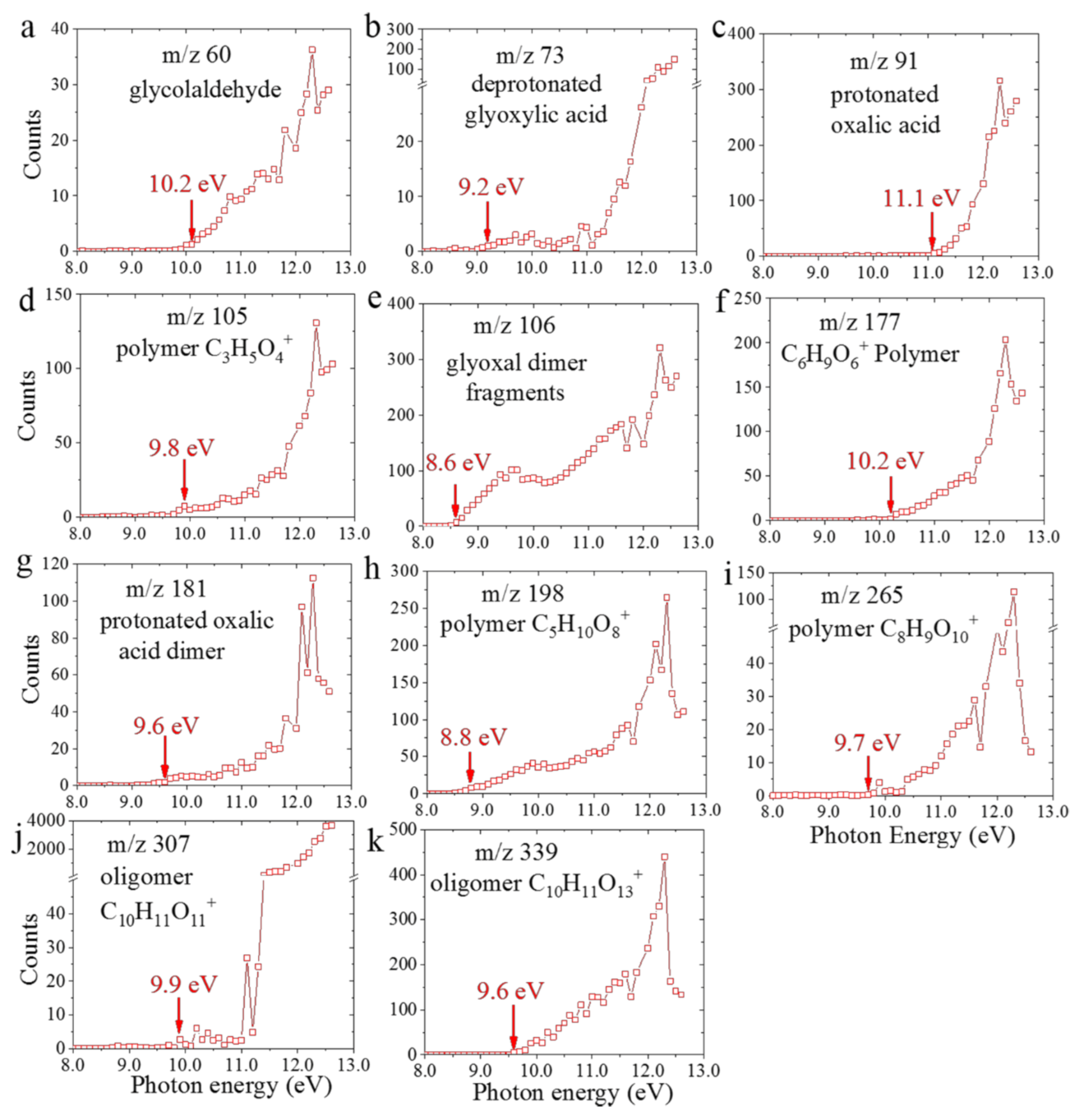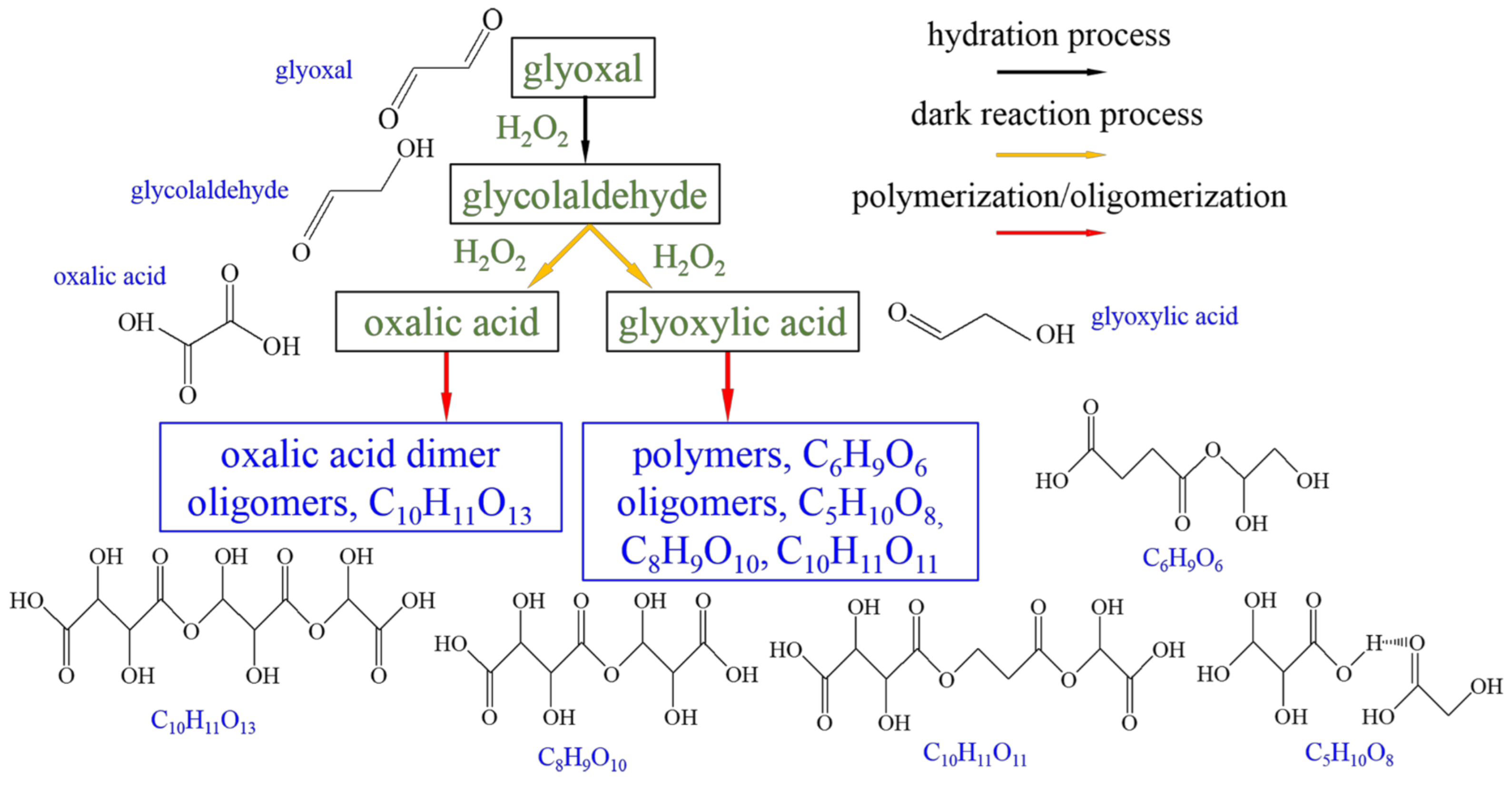Studying Interfacial Dark Reactions of Glyoxal and Hydrogen Peroxide Using Vacuum Ultraviolet Single Photon Ionization Mass Spectrometry
Abstract
:1. Introduction
2. Experiments
2.1. SALVI Fabrication
2.2. Sample Preparation
2.3. VUV SPI-MS Setup
2.4. Data Analysis
3. Results
3.1. Mass Spectra Analysis
3.2. Appearance Energies (AEs) Determination
4. Discussion
5. Conclusions
Supplementary Materials
Author Contributions
Funding
Acknowledgments
Conflicts of Interest
References
- Myriokefalitakis, S.; Vrekoussis, M.; Tsigaridis, K.; Wittrock, F.; Richter, A.; Brühl, C.; Volkamer, R.; Burrows, J.P.; Kanakidou, M. The influence of natural and anthropogenic secondary sources on the glyoxal global distribution. Atmos. Chem. Phys. 2008, 8, 4965–4981. [Google Scholar] [CrossRef] [Green Version]
- Atkinson, R.; Arey, J. Atmospheric Degradation of Volatile Organic Compounds. Chem. Rev. 2003, 103, 4605–4638. [Google Scholar] [CrossRef]
- Volkamer, R.; Molina, L.T.; Molina, M.J.; Shirley, T.; Brune, W.H. DOAS measurement of glyoxal as an indicator for fast VOC chemistry in urban air. Geophys. Res. Lett. 2005, 32. [Google Scholar] [CrossRef] [Green Version]
- Miller, C.C.; Jacob, D.J.; Marais, E.A.; Yu, K.; Travis, K.R.; Kim, P.S.; Fisher, J.A.; Zhu, L.; Wolfe, G.M.; Hanisco, T.F.; et al. Glyoxal yield from isoprene oxidation and relation to formaldehyde: Chemical mechanism, constraints from SENEX aircraft observations, and interpretation of OMI satellite data. Atmos. Chem. Phys. 2017, 17, 8725–8738. [Google Scholar] [CrossRef] [Green Version]
- Mellouki, A.; Wallington, T.J.; Chen, J. Atmospheric Chemistry of Oxygenated Volatile Organic Compounds: Impacts on Air Quality and Climate. Chem. Rev. 2015, 115, 3984–4014. [Google Scholar] [CrossRef] [PubMed]
- Huang, R.-J.; Zhang, Y.; Bozzetti, C.; Ho, K.-F.; Cao, J.-J.; Han, Y.; Daellenbach, K.R.; Slowik, J.G.; Platt, S.M.; Canonaco, F.; et al. High secondary aerosol contribution to particulate pollution during haze events in China. Nature 2014, 514, 218–222. [Google Scholar] [CrossRef] [Green Version]
- Ito, T.; Bekki, K.; Fujitani, Y.; Hirano, S. The toxicological analysis of secondary organic aerosol in human lung epithelial cells and macrophages. Environ. Sci. Pollut. Res. 2019, 26, 22747–22755. [Google Scholar] [CrossRef]
- Li, J.; Zhu, C.; Chen, H.; Fu, H.; Herrmann, H.; Chen, J. A More Important Role for the Ozone S(IV) Oxidation Pathway Due to Decreasing Acidity in Clouds. J. Geophys. Res. Atmos. 2020, 125, 1–13. [Google Scholar] [CrossRef]
- Herrmann, H.; Schaefer, T.; Tilgner, A.; Styler, S.A.; Weller, C.; Teich, M.; Otto, T. Tropospheric Aqueous-Phase Chemistry: Kinetics, Mechanisms, and Its Coupling to a Changing Gas Phase. Chem. Rev. 2015, 115, 4259–4334. [Google Scholar] [CrossRef]
- Vaida, V. Atmospheric radical chemistry revisited sunlight may directly drive previously unknown organic reactions at environmental surfaces. Science 2016, 353, 650. [Google Scholar] [CrossRef] [PubMed]
- McNeill, V.F. Aqueous organic chemistry in the atmosphere: Sources and chemical processing of organic aerosols. Environ. Sci. Technol. 2015, 49, 1237–1244. [Google Scholar] [CrossRef]
- Yu, X.Y.; Liu, B.W.; Yang, L. Imaging liquids using microfluidic cells. Microfluid. Nanofluid. 2013, 15, 725–744. [Google Scholar] [CrossRef]
- Kostko, O.; Bandyopadhyay, B.; Ahmed, M. Vacuum Ultraviolet Photoionization of Complex Chemical Systems. Annu. Rev. Phys. Chem. 2016, 67, 19–40. [Google Scholar] [CrossRef] [Green Version]
- Ahmed, M.; Kostko, O. From atoms to aerosols: Probing clusters and nanoparticles with synchrotron based mass spectrometry and X-ray spectroscopy. Phys. Chem. Chem. Phys. 2020, 22, 2713–2737. [Google Scholar] [CrossRef] [Green Version]
- Craig, A.; Taatjes, N.H.; Andrew McIlroy, J.A.M.; Juan, P.S.; Stephen, J.K.; Qi, F.; Sheng, L.; Zhang, Y.; Terrill, A.; Wang, C.J.; et al. Enols Are Common Intermediates in Hydrocarbon Oxidation. Science 2005, 308, 1887–1889. [Google Scholar]
- Mysak, E.R.; Wilson, K.R.; Jimenez-Cruz, M.; Ahmed, M.; Baer, T. Synchrotron radiation based aerosol time-of-flight mass spectrometry for organic constituents. Anal. Chem. 2005, 77, 5953–5960. [Google Scholar] [CrossRef] [PubMed]
- Yang, L.; Yu, X.Y.; Zhu, Z.H.; Iedema, M.J.; Cowin, J.P. Probing liquid surfaces under vacuum using SEM and ToF-SIMS. Lab Chip 2011, 11, 2481–2484. [Google Scholar] [CrossRef] [PubMed]
- Yang, L.; Yu, X.Y.; Zhu, Z.H.; Thevuthasan, T.; Cowin, J.P. Making a hybrid microfluidic platform compatible for in situ imaging by vacuum-based techniques. J. Vac. Sci. Technol. A 2011, 29, 061101. [Google Scholar] [CrossRef]
- Komorek, R.; Xu, B.; Yao, J.; Ablikim, U.; Troy, T.P.; Kostko, O.; Ahmed, M.; Yu, X.Y. Enabling liquid vapor analysis using synchrotron VUV single photon ionization mass spectrometry with a microfluidic interface. Rev. Sci. Instrum. 2018, 89, 115105. [Google Scholar] [CrossRef] [Green Version]
- Komorek, R.; Xu, B.; Yao, J.; Kostko, O.; Ahmed, M.; Yu, X.Y. Probing sulphur clusters in a microfluidic electrochemical cell with synchrotron-based photoionization mass spectrometry. Phys. Chem. Chem. Phys. 2020, 22, 14449–14453. [Google Scholar] [CrossRef]
- Lim, Y.B.; Tan, Y.; Perri, M.J.; Seitzinger, S.P.; Turpin, B.J. Aqueous chemistry and its role in secondary organic aerosol (SOA) formation. Atmos. Chem. Phys. 2010, 10, 10521–10539. [Google Scholar] [CrossRef] [Green Version]
- Ervens, B.; Volkamer, R. Glyoxal processing by aerosol multiphase chemistry: Towards a kinetic modeling framework of secondary organic aerosol formation in aqueous particles. Atmos. Chem. Phys. 2010, 10, 8219–8244. [Google Scholar] [CrossRef] [Green Version]
- Zhang, F.; Yu, X.; Chen, J.; Zhu, Z.; Yu, X.-Y. Dark air–liquid interfacial chemistry of glyoxal and hydrogen peroxide. NPJ Clim. Atmos. Sci. 2019, 2. [Google Scholar] [CrossRef]
- Sui, X.; Zhou, Y.F.; Zhang, F.; Chen, J.M.; Zhu, Z.H.; Yu, X.Y. Deciphering the aqueous chemistry of glyoxal oxidation with hydrogen peroxide using molecular imaging. Phys. Chem. Chem. Phys. 2017, 19, 20357–20366. [Google Scholar] [CrossRef]
- Sui, X.; Xu, B.; Yao, J.; Kostko, O.; Ahmed, M.; Yu, X.-Y. New Insights into Secondary Organic Aerosol Formation at the Air–Liquid Interface. J. Phys. Chem. Lett. 2020, 324–329. [Google Scholar] [CrossRef]
- Galloway, M.M.; Chhabra, P.S.; Chan, A.W.H.; Surratt, J.D.; Flagan, R.C.; Seinfeld, J.H.; Keutsch, F.N. Glyoxal uptake on ammonium sulphate seed aerosol: Reaction products and reversibility of uptake under dark and irradiated conditions. Atmos. Chem. Phys. 2009, 9, 3331–3345. [Google Scholar] [CrossRef] [Green Version]
- Carlton, A.G.; Turpin, B.J.; Altieri, K.E.; Seitzinger, S.; Reff, A.; Lim, H.-J.; Ervens, B. Atmospheric oxalic acid and SOA production from glyoxal: Results of aqueous photooxidation experiments. Atmos. Environ. 2007, 41, 7588–7602. [Google Scholar] [CrossRef]
- Zhang, F.; Yu, X.; Sui, X.; Chen, J.; Zhu, Z.; Yu, X.Y. Evolution of aqSOA from the Air-Liquid Interfacial Photochemistry of Glyoxal and Hydroxyl Radicals. Environ. Sci. Technol. 2019, 53, 10236–10245. [Google Scholar] [CrossRef] [PubMed]
- Li, J.; Zhu, C.; Chen, H.; Zhao, D.; Xue, L.; Wang, X.; Li, H.; Liu, P.; Liu, J.; Zhang, C.; et al. The evolution of cloud and aerosol microphysics at the summit of Mt. Tai, China. Atmos. Chem. Phys. 2020, 20, 13735–13751. [Google Scholar] [CrossRef]
- Yu, J.C.; Zhou, Y.F.; Hua, X.; Liu, S.Q.; Zhu, Z.H.; Yu, X.Y. Capturing the transient species at the electrode-electrolyte interface by in situ dynamic molecular imaging. Chem. Commun. 2016, 52, 10952–10955. [Google Scholar] [CrossRef] [PubMed]
- Liu, B.; Yu, X.Y.; Zhu, Z.; Hua, X.; Yang, L.; Wang, Z. In situ chemical probing of the electrode-electrolyte interface by ToF-SIMS. Lab Chip 2014, 14, 855–859. [Google Scholar] [CrossRef] [PubMed]
- Bell, F.; Ruan, Q.N.; Golan, A.; Horn, P.R.; Ahmed, M.; Leone, S.R.; Head-Gordon, M. Dissociative photoionization of glycerol and its dimer occurs predominantly via a ternary hydrogen-bridged ion-molecule complex. J. Am. Chem. Soc. 2013, 135, 14229–14239. [Google Scholar] [CrossRef] [Green Version]
- Ptasińska, S.; Denifl, S.; Scheier, P.; Märk, T.D. Electron impact ionization of glycolaldehyde. Int. J. Mass Spectrom. 2005, 243, 171–176. [Google Scholar] [CrossRef]
- Perri, M.J.; Seitzinger, S.; Turpin, B.J. Secondary organic aerosol production from aqueous photooxidation of glycolaldehyde: Laboratory experiments. Atmos. Environ. 2009, 43, 1487–1497. [Google Scholar] [CrossRef]
- Strukul, G. Transition Metal Catalysis in the Baeyer–Villiger Oxidation of Ketones. Angew. Chem. Int. Ed. 1998, 37, 1198–1209. [Google Scholar] [CrossRef]
- Warneck, P. In-cloud chemistry opens pathway to the formation of oxalic acid in the marine atmosphere. Atmos. Environ. 2003, 37, 2423–2427. [Google Scholar] [CrossRef]
- Mariusz, P.; Mitoraj, R.K.; Boczar, M.; Michalak, A. Theoretical description of hydrogen bonding in oxalic acid dimer and trimer based on the combined extended-transition-state energy decomposition analysis and natural orbitals for chemical valence (ETS-NOCV). J. Mol. Model. 2010, 16, 1789–1795. [Google Scholar]
- Tan, Y.; Carlton, A.G.; Seitzinger, S.P.; Turpin, B.J. SOA from methylglyoxal in clouds and wet aerosols: Measurement and prediction of key products. Atmos. Environ. 2010, 44, 5218–5226. [Google Scholar] [CrossRef]
- Hanley, L.; Zimmermann, R. Light and molecular ions: The emergence of vacuum UV single-photon ionization in MS. Anal. Chem. 2009, 81, 4174–4182. [Google Scholar] [CrossRef] [PubMed] [Green Version]
- Ding, Y.; Zhou, Y.; Yao, J.; Szymanski, C.; Fredrickson, J.K.; Shi, L.; Cao, B.; Zhu, Z.; Yu, X.Y. In Situ Molecular Imaging of the Biofilm and Its Matrix. Anal. Chem. 2016. [Google Scholar] [CrossRef]
- Hua, X.; Szymanski, C.; Wang, Z.; Zhou, Y.; Ma, X.; Yu, J.; Evans, J.; Orr, G.; Liu, S.; Zhu, Z.; et al. Chemical imaging of molecular changes in a hydrated single cell by dynamic secondary ion mass spectrometry and super-resolution microscopy. Integr. Biol. 2016, 8, 635–644. [Google Scholar] [CrossRef] [PubMed]




| m/zobsa | m/ztheb | Formula | Structure | Chemical Name | AEs c, UV (eV) | AEs f, Dark (eV) |
|---|---|---|---|---|---|---|
| 46 | 46.03 | CH2O2+ | HCOOH | acetic acid/formic acid | 10.6, 11.4 | - e |
| 60 d | 60.05 | C2H4O2 | CHOCH2OH | glycolaldehyde | 10.2 | 10.0 |
| 73 d | 73.07 | C2HO3+ | CHOCOOH | deprotonated glyoxylic acid | 9.2 | 9.2 |
| 75 | 75.04 | C2H3O3+ | CH2OHCOOH | deprotonated glycolic acid | 10.2 | - e |
| 78 | 78.07 | C2H6O3+ | CH2OHCH2OH | monohydrated glycolaldehyde | 9.3 | - e |
| 82 | 82.06 | C4H2O2+ | C=CCHOCHO | cyclobutene dione | 9.8 | - e |
| 91 d | 91.04 | C2H3O4+ | COOHCOOH | protonated oxalic acid | 11.1 | 11.1 |
| 105 d | 105.07 | C3H5O4+ | HOOCCH2COOH | polymer | 9.8 | 9.8 |
| 106 d | 106.08 | C3H6O4+ | CHOHCH2CHOH | glyoxal dimer fragments | 8.6 | 8.6 |
| 118 | 118.13 | C5H10O3+ | HOOCCH2CH2COOH | succinic acid | 9.7 | - e |
| 122 | 122.08 | C3H6O5+ | COOHCHOHCH(OH)2 | polymer | 9.5 | - e |
| 149 | 149.08 | C4H5O6+ | HOOCCHOHCHOHCOOH | deprotonated tartaric acid | 9.9 | - e |
| 177 d | 177.13 | C6H9O6+ | COOHCH2CH2COOCHOHCH2OH | polymer | 10.1 | 10.2 |
| 181 d | 181.08 | C4H5O8+ | (COOHCOOH)2 | protonated oxalic acid dimer | 9.6 | 9.6 |
| 194 | 194.14 | C5H6O8+ | COOHCHOHCHOHCOOCOOH | polymer | 9.7 | - e |
| 198 d | 198.13 | C5H10O8+ | COOHCHOH---COOHCHOHCH(OH)2 g | oligomer | 8.8 | 8.8 |
| 265 d | 265.15 | C8H9O10+ | COOHCHOHCHOHCOOCHOHCHOHCOOH | oligomer | 9.8 | 9.7 |
| 284 | 284.13 | C7H8O12+ | (COOHCOOH)2---CHOCHOHCOOH | oligomer | 9.0 | - e |
| 307 d | 307.23 | C10H11O11+ | COOHCHOHCHOHCOOCH2CH2COOCHOHCOOH | oligomer | 9.7 | 9.9 |
| 339 d | 339.19 | C10H11O13+ | COOHCHOHCHOHCOOCHOHCHOHCOOCHOHCOOH | oligomer | 9.7 | 9.6 |
Publisher’s Note: MDPI stays neutral with regard to jurisdictional claims in published maps and institutional affiliations. |
© 2021 by the authors. Licensee MDPI, Basel, Switzerland. This article is an open access article distributed under the terms and conditions of the Creative Commons Attribution (CC BY) license (http://creativecommons.org/licenses/by/4.0/).
Share and Cite
Sui, X.; Xu, B.; Yu, J.; Kostko, O.; Ahmed, M.; Yu, X.Y. Studying Interfacial Dark Reactions of Glyoxal and Hydrogen Peroxide Using Vacuum Ultraviolet Single Photon Ionization Mass Spectrometry. Atmosphere 2021, 12, 338. https://doi.org/10.3390/atmos12030338
Sui X, Xu B, Yu J, Kostko O, Ahmed M, Yu XY. Studying Interfacial Dark Reactions of Glyoxal and Hydrogen Peroxide Using Vacuum Ultraviolet Single Photon Ionization Mass Spectrometry. Atmosphere. 2021; 12(3):338. https://doi.org/10.3390/atmos12030338
Chicago/Turabian StyleSui, Xiao, Bo Xu, Jiachao Yu, Oleg Kostko, Musahid Ahmed, and Xiao Ying Yu. 2021. "Studying Interfacial Dark Reactions of Glyoxal and Hydrogen Peroxide Using Vacuum Ultraviolet Single Photon Ionization Mass Spectrometry" Atmosphere 12, no. 3: 338. https://doi.org/10.3390/atmos12030338






